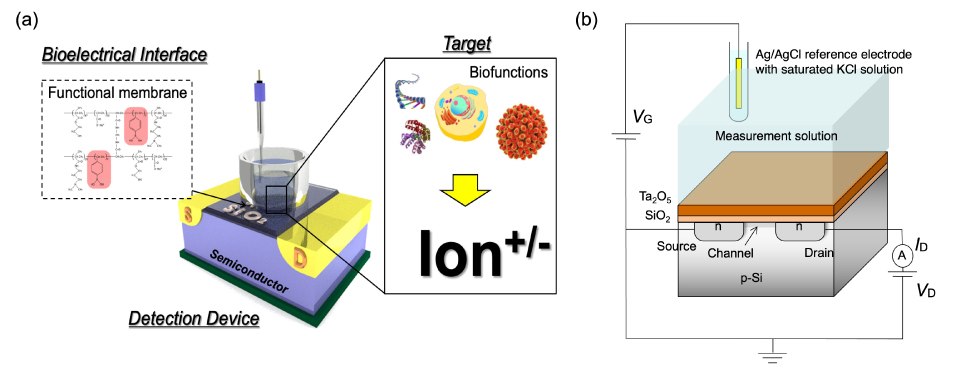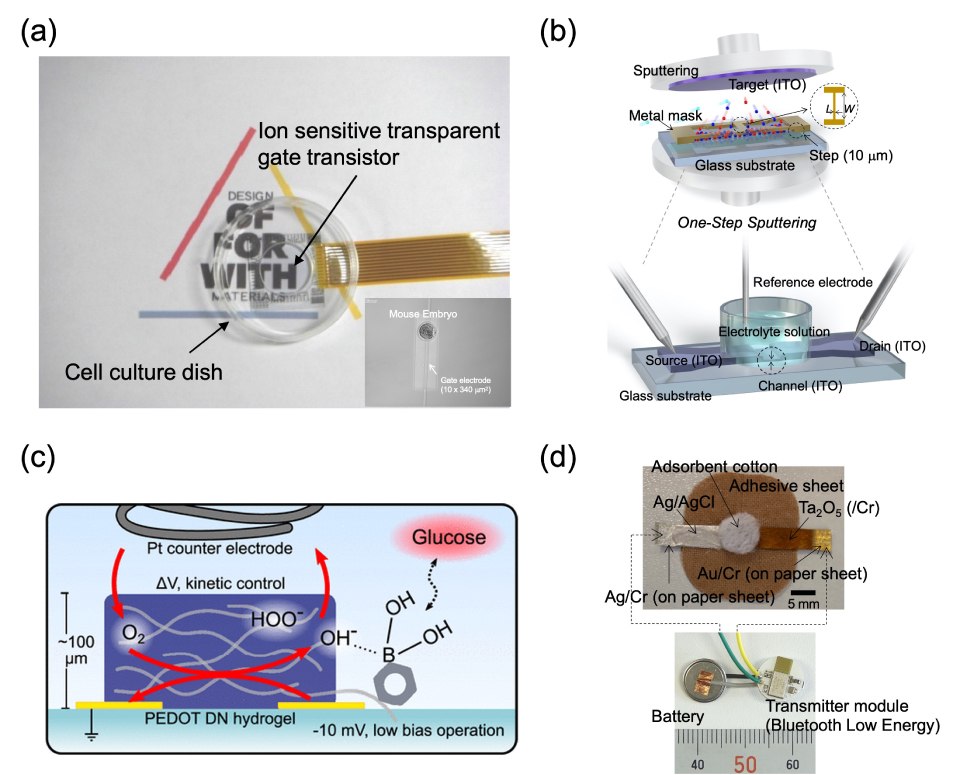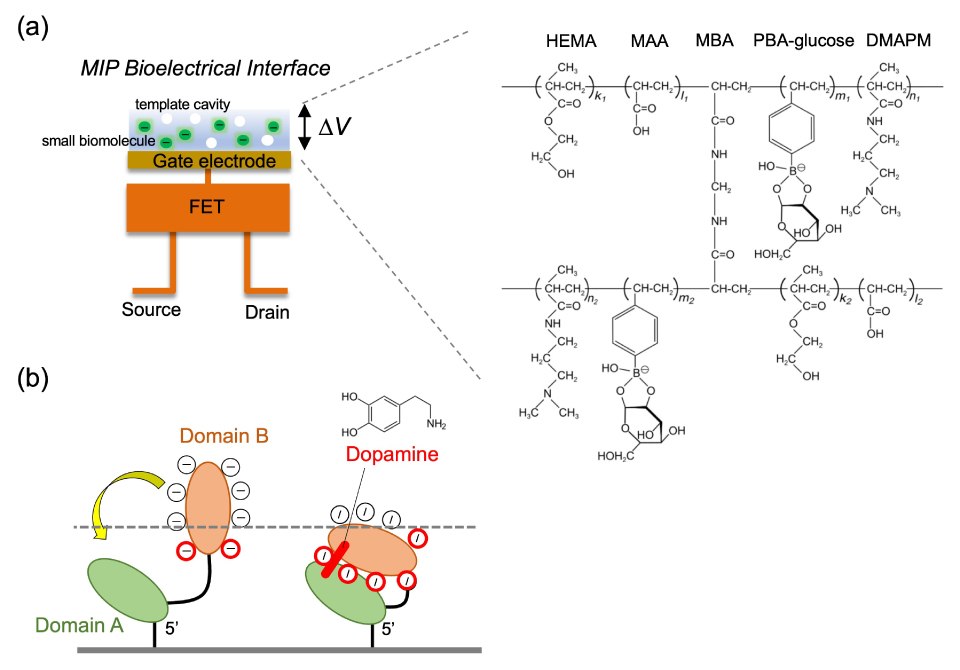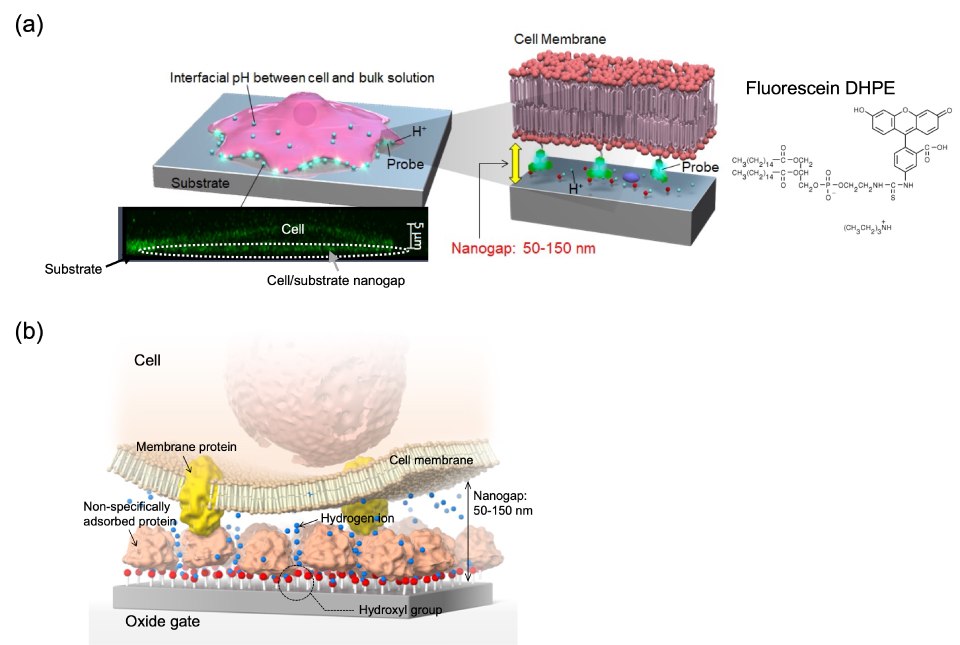Solution Gated Field Effect Transistors for Biosensing Applications
Toshiya Sakata
Department of Materials Engineering, School of Engineering, The University of Tokyo, 7-3-1 Hongo, Bunkyo-ku, Tokyo 113-8656, Japan
Introduction
The behavior of ions and biomolecules has an intriguing connection to biological phenomena. Because of this, biosensing tools that facilitate the identification of ionic and biomolecular charges aid in the label- and enzyme-free direct analysis of biological processes. Potentiometric biosensors such as biologically coupled gate field- effect transistor (bio-FET) sensors, which allow the direct detection of these charges based on the field effect, have this capability. Bio- FETs are suitable for use as simple devices for in vitro diagnostics (IVD), which can be used to monitor a person’s overall health to help cure, treat, or prevent diseases.1,2 Using bio-FET sensors, various biological ionic behaviors generated by biomolecular recognition events (e.g., antigen–antibody interactions,3 DNA (deoxyribonucleic acid) hybridization,4–9 and enzymatic reactions) and cellular activities (e.g., neuronal transmission, cellular respiration,10–14 extracellular acidosis,15 and autophagy16) are being targeted for clinical diagnostics, as well as studies in cell biology and neuroscience. To realize these applications, bioelectrical interfaces should be formed between the electrolyte solution and the gate electrode by modifying artificially synthesized biomimetic membranes. As a result, targets are detected selectively depending on the intrinsic charges present on the gate surface.17–23 Depending on the application field, various types of semiconducting material, not only inorganic semiconductors24–26 but also organic semiconductors,27 can be selected for use in bio- FET sensors. Therefore, in developing novel biosensing devices, the biological target’s structural components, the bioelectrical interface, and the detection device must be considered (Figure 1A).

Figure 1.A) Conceptual structure of biologically coupled gate field-effect transistor (bio-FET). B) Schematic illustration of solution-gated FET.
Semiconducting Materials for Solution-gated FETs
To detect ions in biological settings, a solution-gated, ion-sensitive FET (ISFET) was proposed. While a reference electrode must be used in the solution, it is believed that an electrolyte solution, rather than a metal gate in a metal-oxide-semiconductor (MOS) transistor, will induce the interfacial potential between the solution and the gate insulator in this device (Figure 1B). Since the change in surface charge is detected from the change in pH based on the principle of the field effect (Nernstian response),28–30 considering the effect of other cations, oxide or nitride membranes such as Ta2O5, Al2O3, Si3N4, Ti/TiN (Cat. No. FIPMS267), and SiO2 (Cat. Nos. FIPMS176, FIPMS148, FIPMS175, FIPMS223) are frequently used as gate insulators. As a result, hydroxyl groups at the oxide or nitride surface in a solution undergo the equilibrium reaction with hydrogen ions through protonation (-OH + H+ ⇄ -OH2+) and deprotonation (-OH ⇄ -O- + H+).31 This is why the original ISFET sensor is utilized as a pH sensor. Such ISFET sensors mostly have a Si substrate. Still, various semiconducting materials have recently been applied to pH sensitive ISFET sensors, requiring the gate surface in contact with the electrolyte solution to be covered by functional groups such as hydroxy, carboxy, and amino groups.
For example, a transparent amorphous oxide semiconductor (a-InGaZnO) was utilized as the channel between the transparent conductive source and drain indium tin oxide (ITO) electrodes, on which SiO2 was thinly coated as the gate insulator in a pH-sensitive ISFET.24 This transparent ion-sensitive thin-film transistor (ISTFT) can continuously monitor cellular respiration as a change in pH while clearly observing cellular morphologies under an inverted microscope (Figure 2A). Also, such ISTFT sensors were fabricated effortlessly, that is, a one-step procedure with sputtering, thus providing “all-by-ITO” (Cat. Nos. 917311, 917826, 917567, 918067) technology (Figure 2B).25 A thin-film sheet was placed on both ends of a metal shadow mask, which was contacted with a glass substrate. That is, the bottom of the metal shadow mask corresponding to the channel was slightly raised from the substrate, resulting in the creeping of some particles into the gap during sputtering. Owing to this modified metal shadow mask, a thin ITO channel (< 30–40 nm) and thick ITO source/drain electrodes (ca. 100 nm) were simultaneously fabricated during the one-step sputtering. The thickness of ITO films was critical for them to be semiconductive, depending on the maximum depletion width (~ 30–40 nm per ITO channel), similar to 2D materials. The ultrathin ITO channel also worked as an ion-sensitive membrane, owing to the intrinsic oxidized surface in direct contact with an electrolyte solution. The 20-nm-thick channel ITO-based FET that is solution- gated showed an ideal pH responsivity (~56 mV/pH), allowing for the real-time monitoring of cellular respiration and the long-term stability of electrical properties for a month. This was attributed to the electric double-layer capacitance at the electrolyte solution/ channel interface and the absence of interfacial traps among electrodes formed in one step. Moreover, the chemical modification of the ITO channel surface likely contributed to biomolecular recognition with ultrahigh sensitivity owing to the remarkably steep SS, which provided the exponential pH sensitivity in the subthreshold regime.26 Our new device produced in this one-step manner has excellent future potential in bioelectronics.

Figure 2.A) Ion-sensitive transparent-gate transistor (ISTGT) for visible cell sensing. B) One-step sputtering with controlled metal shadow mask for the all-by-ITO technology and conceptual structure of the solution-gated ultrathin channel ITO-based FET sensor. C) Double-network hydrogel in an OECT configuration and proposed mechnism for glucose sensing. D) Paper-based metal electrode and electrical measurement system for wireless sensing.
Moreover, wearable biosensors have recently been attracting interest in health monitoring. Distinct types of wireless biosensors are integrated to simultaneously monitor ions and biomolecules in biological fluids, such as sweat on a flexible substrate. Using such wearable biosensors, we can monitor our health noninvasively in real time without collecting blood samples with needles. The obtained data of an individual should be accumulated and analyzed on an electronic device connected to the internet so that it can be easily shared with their family and doctors, as well as the person in question, as part of health checks and for the early diagnosis of diseases. Furthermore, biocompatible electrodes (flexible and nontoxic), are required for wearable devices applied as patches on a body; hydrogels are available for flexible and nontoxic electrodes. In composite hydrogels, the high electrical performance of poly(3,4-ethylenedioxythiophene) complexed with poly(styrene sulfonate) (PEDOT:PSS, Cat. Nos. 483095, 900208, 900181) was integrated with complementary structural and electrochemical functions via a rationally designed poly(acrylamide) second network incorporating phenylboronic acid (PBA, Cat. No. 78181).27 Free-standing double-network hydrogels prepared by a simple one-pot radical polymerization exhibited state-of-the-art electrical conductivity (∼20 S cm−1 in phosphate buffered saline) while retaining a degree of hydration similar to biological soft tissues. Low-resistance contacts to Au electrodes were formed via facile thermo-mechanical annealing. They demonstrated stability over a month of continuous immersion, thus enabling hydrogels to serve as channels for organic electrochemical transistors (OECTs).
A kinetic basis for glucose detection via diol esterification on PBA was identified as the coupling of PBA equilibrium to electrocatalyzed O2 reduction occurring on PEDOT in cathodic potentials (Figure 2C). Hydrogel OECTs inherently amplify this direct electrochemical signal, demonstrating the viability of a new class of soft, structural biosensors. Also, a paper-based electrode is an attractive component for a disposable, nontoxic, and flexible biosensor. We demonstrated the detection ability of paper-based metal electrodes for wearable biosensors as part of a wireless potentiometric measurement system, focusing on detecting pH and sodium ions.32 The paper-based metal electrodes were obtained by simply coating a silicone-rubber-coated paper sheet with an Au (/Cr) thin film by sputtering and then modifying it with different functional membranes such as an oxide membrane (Ta2O5) and a fluoropolysilicone (FPS)-based Na+-sensitive membrane, corresponding to the targeted ions. Satisfactory and stable detection sensitivities of the modified paper-based Au electrodes were obtained over several weeks, even when bent to a curvature radius of 6.5 to 25 mm, assuming use in a flexible body patch biosensor. Moreover, the Na+ concentration in a sweat sample was evaluated using the paper-based Au electrode with the FPS-based Na+-sensitive membrane in a wireless and real-time manner where the electrode was bent (Figure 2D). Thus, due to their complex mesh structure, flexible paper sheets should be suitable as potentiometric electrodes for wearable wireless biosensors.
Bioelectrical Interface to Induce Electrical Signal Based on the Biological Target
The first concept of an enzyme electrode was proposed by Updike et al. in 1967.33 Glucose oxidase (GOx) was immobilized in a gel, which has often been utilized for glucose sensors such as self-monitoring blood glucose (SMBG) and continuous glucose monitoring (CGM) systems for diabetic patients. The enzymatic reaction between GOx and glucose generates hydroxy peroxide (H2O2), resulting in a redox reaction with a platinum electrode, which is electrochemically detected by amperometric measurement.
Then, various enzymes, such as lactate dehydrogenase and penicillinase, were utilized for the electrochemical detection of biomolecules. These enzymes are biomimetic, which originated from biofunctions. However, the use of enzymes is problematic owing to their lack of stability, high-cost and time-consuming production, and the difficulty of quality control in their production.
A bioelectrical interface indicates a sample solution/electrode interface, where not only enzyme membranes but also polymeric functional films and probe biomolecules such as antibodies and single-stranded oligonucleotides are immobilized on the electrode. A molecularly imprinted polymer (MIP) film is artificially modified to selectively capture target biomolecules on electrodes, including the main monomer, a cross-linker, and a functional monomer.19–23 A target biomolecule specifically binds to the functional groups around a template cavity in the MIP membrane, which should contribute to a change in molecular charge density as an electrical signal. MIP-coated gate FET sensors directly and selectively detected small biomolecules (diol compounds) such as glucose, dopamine, lactic acid, histamine, and oligosaccharides in an enzyme-/antibody-free and label-free manner (Figure 3A).19–23

Figure 3.A) Conceptual structure of MIP-coated gate FET sensor. B) Detetion mechnism of dopamine with aptamer-modified gate FET sensor.
Here, PBA was utilized as the target-interacting functional monomer to design a diol-compound-selective MIP interface on the gate surface. PBA has attracted considerable attention in molecular recognition as it can form stable esters with various biomolecules containing 1,2 or 1,3 cis-diol/polyol groups, such as oligosaccharides, in aqueous systems. Moreover, in esterification, PBA switches from a non-ionic to an anionic form. Hence, the change in the density of molecular charges induced by the diol compound/PBA binding can be detected by bio-FET sensors. Moreover, methacrylic acid (MAA, Cat. No. 8.00578) is the most used functional monomer in the preparation of MIPs (Molecularly Imprinted Polymers) because of its versatility in the interaction. MAA was utilized to interact with amino groups in target small biomolecules such as catecholamines and oligosaccharides to further improve the selectivity of the biosensor. N-[3-(dimethylamino)propyl]methacrylamide (DMAPM, Cat. No. 409472) was used in MIP films with PBA to control the pH owing to its basicity, and 2-hydroxyethyl methacrylate (HEMA) was occasionally utilized as the main chain monomer to improve the hydrophilicity of MIP films, where small biomolecules and electrolytes were included. The polymer was crosslinked by N,N-methylenebisacrylamide (MBA, Cat. No. 146072) or ethylene glycol dimethacrylate (EGDMA, Cat. Nos. 929840, 906859, 907049, 8.18847). Conversely, a nonimprinted polymer (NIP) was synthesized on the gate electrode as a control polymer by employing the identical procedure as for MIP, with the exception of incorporating a tiny biomolecule as the template. The MIP-based bioelectrical interface was also adopted for electrochemical impedance spectroscopy.20 Thus, the MIP films can be effectively employed as an artificial bioelectrical interface for enzyme-and antibody-free and label-free biosensing.
Aptamer molecules are widely used for biosensors as selective receptors to target molecules composed of single-stranded oligonucleotides or peptides. Aptamer-based bioelectrical interfaces can be used to selectively detect biomolecules as signal transduction interfaces with biosensors. This is achieved by identifying the sequence of aptamers using an in vitro selection method called systematic evolution of ligands by exponential enrichment. These interfaces are especially useful when enzymes and antibodies for the target biomolecules are not available.
However, isolating an aptamer for a specific target may require considerable time and expense. In fact, aptamer-based bioelectrical interfaces have recently been utilized for the selective detection of biomolecules using solution-gated FET sensors, and small biomarkers were detected by overcoming the Debye length limitation. The crucial aspect of small-biomarker sensing involves the aptamer undergoing a molecular structure change due to its interaction with small biomarkers on the gate surface. Aptamer molecules have negative charges owing to the phosphate groups on the side chain, such as those in DNA or RNA. The stem–loop structure of dopamine aptamers, featuring negatively charged backbones, was expected to undergo structural reorientation near the gate surface. This reorientation was anticipated due to the selective binding of small biomolecules, such as dopamine (as depicted in Figure 3B). As a result, it was assumed that the negative charges of dopamine aptamers would enter a diffusion layer less affected by counterions. A SARS-CoV-2 aptamer was also immobilized using a spacer molecule on an aryl diazonium monolayer electrochemically deposited with a radical scavenger on the ITO channel surface. Eventually, the solution-gated ITO- based Thin Film Transistors (TFT) with the SARS-CoV-2 aptamer clearly responded to inactivated SARS-CoV-2 particles owing to the successful surface modification.26
Cellular respiration is the process by which living cells use glucose and oxygen to create adenosine triphosphate (ATP) for energy, whereby carbon dioxide is produced as a side product through a series of reactions. Carbon dioxide dissolves in a solution, generating hydrogen ions based on the equilibrium reaction. That is, the culturing of cells induces changes in pH in the culture medium, with the change in pH depending on the cellular activity (Figure 4A). This is why an ISFET sensor can detect a change in pH based on a cell culture in real time. Such an effect of cellular respiration on the change in pH in a culture medium is expected to be significant and directly detected at the interface between cells and the gate surface, the cell/gate nanogap interface. Using the cultured-cell-coupled gate ISFET, a change in the interfacial pH at the cell/gate nanogap based on cellular respiration was also found for embryo activity,10 allergic responses,11chondrocyte organization,14 and autophagy16 as well as canceration.15
The illustration shown in Figure 4B shows the conceptual principle of cellular respiration detection using a cultured-cell-coupled gate ISFET.15 Some proteins in a culture medium are nonspecifically adsorbed at the gate surface, to which cells adhere through adhesion proteins. These proteins prevent other ionic biomolecules from contacting the gate surface. Smaller hydrogen ions easily bind to the gate surface through the nonspecifically adsorbed proteins, where the equilibrium reaction between the hydrogen ions and hydroxyl groups at the oxide gate contributes to the change in the charge density at the gate, which depends on pH. In the context of cultured-cell-coupled gate ISFETs (ion-sensitive FETs), it is important to note that these devices exhibit insensitivity towards most subsequently generated biomolecules. This insensitivity arises from the fact that nonspecifically adsorbed proteins on the gate effectively suppress nonspecific signals originating from biomolecules, thereby minimizing interference. However, these devices remain sensitive and selective towards changes in pH (ΔpH), demonstrating a Nernstian response. Also, hydrogen ions generated by cellular respiration concentrate in the cell/gate nanogap, contributing to the amplification of electrical signals based on ΔpH. Thus, cultured-cell-coupled gate ISFET sensors are the most suitable devices for the nonoptical monitoring of cellular respiration. However, it is often considered that they cannot be used to detect biological components in culture media or whole-blood samples owing to the Debye length limit.

Figure 4.A) Schematic illustration of hydrogen ion behaviour around cell cultured on substrate. The phospholipid fluorescein was used as an extracellular pH indicator (Probe) and fixed to the plasma membrane on the external side of a cell. B) Schematic illustration of cell/gate nanogap interface.
Conclusion
Most biological phenomena are closely related to the behavior of ions and biomolecules. This is why biosensing devices for detecting ionic and biomolecular charges contribute to directly analyzing biological phenomena, both label-free and enzyme-free. Potentiometric biosensors such as bio-FET sensors, which allow the direct detection of these charges based on the field effect, meet this requirement and have been developed as simple devices for IVD. Various biological ionic behaviors generated by biomolecular recognition events and cellular activities are being targeted for clinical diagnostics using bio-FET sensors. Bioelectrical interfaces should be formed between the electrolyte solution and the gate electrode to realize these applications by modifying artificially synthesized and biomimetic membranes, resulting in the selective detection of targets based on intrinsic molecular charges. Specific and selective detection of targeted biomolecules is achieved by utilizing MIP (molecularly imprinted polymer) membranes and aptamer molecules. These artificial, synthetically produced bioelectrical interfaces address certain concerns associated with natural materials like enzymes, such as stability issues and the high cost and time required for their production. Note that the change in the density of molecular charges based on biomolecular recognition events should be induced at such functional bioelectrical interfaces for bio-FET sensors. Several types of semiconducting material, not only inorganic semiconductors (e.g., Si, a-InGaZnO, ITO) but also organic semiconductors like PEDOT:PSS, can be selected for use in bio-FET sensors, depending on the application field. In addition, a semiconductor integrated circuit device is also ideal for the massively parallel detection of multiple samples. Thus, platforms based on bio-FET sensors are suitable for use in simple and miniaturized electrical circuit systems for IVD to enable the prevention and early detection of diseases.
Notes
The authors declare no competing financial interest.
Acknowledgments
We would like to thank the members of Sakata Laboratory for their help and valuable discussion.
References
To continue reading please sign in or create an account.
Don't Have An Account?